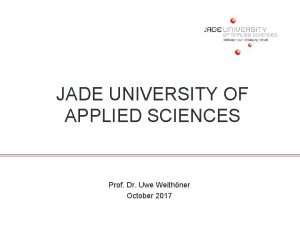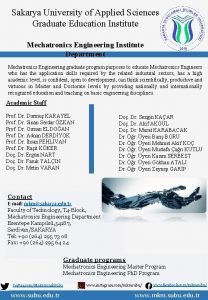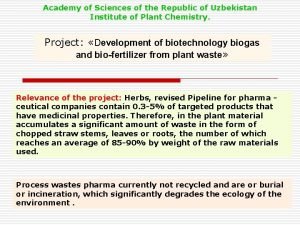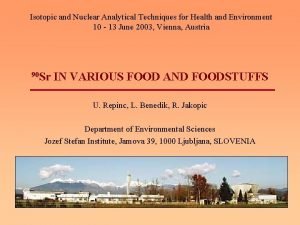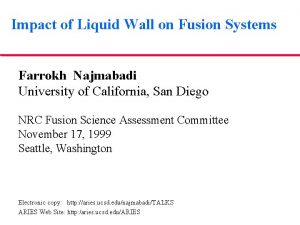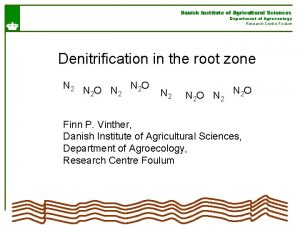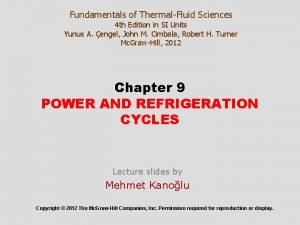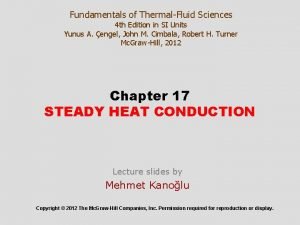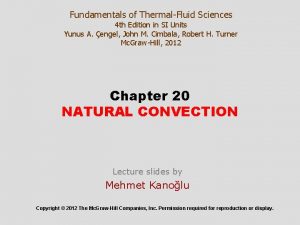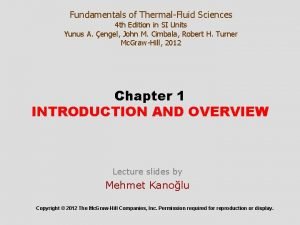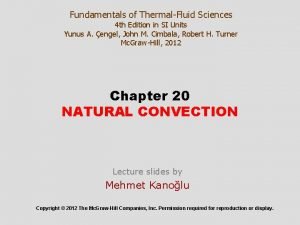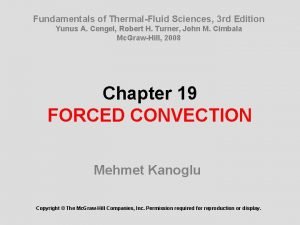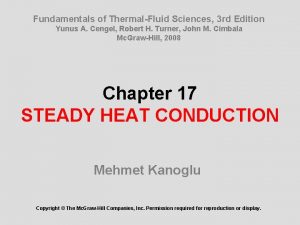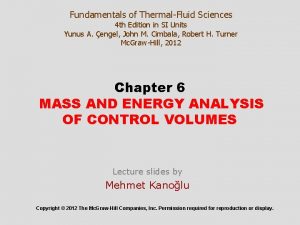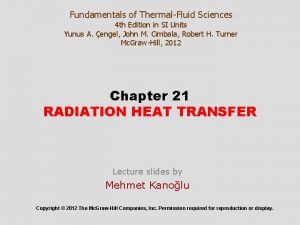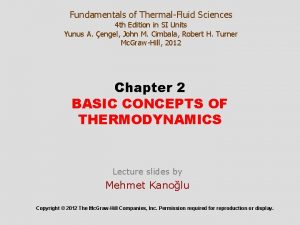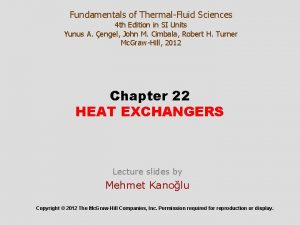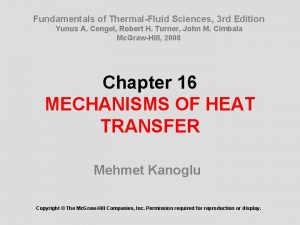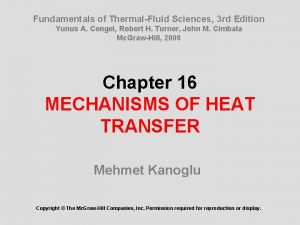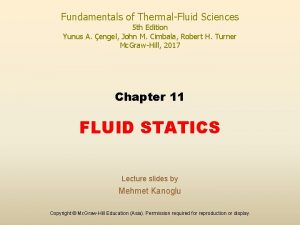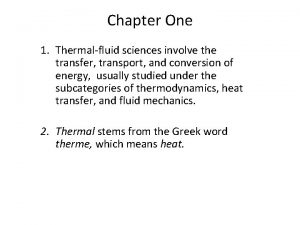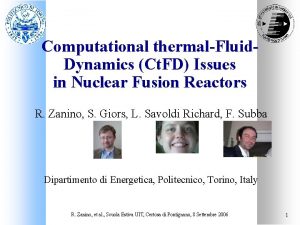Fundamentals of ThermalFluid Sciences 4 th Edition in
































































- Slides: 64

Fundamentals of Thermal-Fluid Sciences 4 th Edition in SI Units Yunus A. Çengel, John M. Cimbala, Robert H. Turner Mc. Graw-Hill, 2012 Chapter 19 FORCED CONVECTION Lecture slides by Mehmet Kanoğlu Copyright © 2012 The Mc. Graw-Hill Companies, Inc. Permission required for reproduction or display.

Objectives • Understand the physical mechanism of convection and its classification • Visualize the development of velocity and thermal boundary layers during flow over surfaces • Gain a working knowledge of the dimensionless Reynolds, Prandtl, and Nusselt numbers • Develop an understanding of the mechanism of heat transfer in turbulent flow. • Evaluate the heat transfer associated with flow over a flat plate for both laminar and turbulent flow, and flow over cylinders and spheres. • Have a visual understanding of different flow regions in internal flow, and calculate hydrodynamic and thermal entry lengths. • Analyze heating and cooling of a fluid flowing in a tube under constant surface temperature and constant surface heat flux conditions, and work with the logarithmic mean temperature difference. • Determine the Nusselt number in fully developed turbulent flow using empirical relations, and calculate the heat transfer rate. 2

Introduction to Convection • Convection denotes energy transfer between a surface and a fluid moving over the surface. • The dominant contribution due to the bulk (or gross) motion of fluid particles. • In this chapter we will ü Introduce the convection transfer equations ü Discuss the physical mechanisms underlying convection ü Discuss physical origins and introduce relevant dimensionless parameters that can help us to perform convection transfer calculations in subsequent chapters. • Note similarities between heat, mass and momentum transfer.

Convection in daily life • We turn on the fan on hot summer days to help our body cool more effectively. The higher the fan speed, the better we feel. • We stir our soup and blow on a hot slice of pizza to make them cool faster. • The air on windy winter days feels much colder than it actually is. • The simplest solution to heating problems in electronics packaging is to use a large enough fan. 4

Classifications • Forced vs Natural Convection • Turbulent vs Laminar Flows • External vs Internal Flows • Constant Temperature vs Constant Heat Flux 5

19 -1 PHYSICAL MECHANISM OF CONVECTION Conduction and convection both require the presence of a material medium but convection requires fluid motion. Convection involves fluid motion as well as heat conduction. Heat transfer through a solid is always by conduction. Heat transfer through a fluid is by convection in the presence of bulk fluid motion and by conduction in the absence of it. Therefore, conduction in a fluid can be viewed as the limiting case of convection, corresponding to the case of quiescent fluid. 6

The fluid motion enhances heat transfer, since it brings warmer and cooler chunks of fluid into contact, initiating higher rates of conduction at a greater number of sites in a fluid. The rate of heat transfer through a fluid is much higher by convection than it is by conduction. In fact, the higher the fluid velocity, the higher the rate of heat transfer. Heat transfer through a fluid sandwiched between two parallel plates. 7

Convection heat transfer strongly depends on the fluid properties dynamic viscosity, thermal conductivity, density, and specific heat, as well as the fluid velocity. It also depends on the geometry and the roughness of the solid surface, in addition to the type of fluid flow (such as being streamlined or turbulent). Newton’s law of cooling Convection heat transfer coefficient, h: The rate of heat transfer between a solid surface and a fluid per unit surface area per unit temperature difference. 8

The Central Question for Convection § Convection heat transfer strongly depends on § Fluid properties - dynamic viscosity, thermal conductivity, density, and specific heat § Flow conditions - fluid velocity, laminar, turbulence. § Surface geometry – geometry, surface roughness of the solid surface. § In fact, the question of convection heat transfer comes down to determining the heat transfer coefficient, h. § This MAINLY depends on the velocity and thermal boundary layers. 9

Flow & Thermal Considerations What is Velocity & Thermal Boundary Layers ? 10

Flow & Thermal Considerations Velocity Boundary Layers – Physical meaning/features Ø A consequence of viscous effects associated with relative motion between a fluid and a surface Ø A region of the flow characterised by shear stresses and velocity gradients. Ø A region between the surface and the free stream whose thickness, increases in the flow direction. Ø why does increase in the flow direction ? - the viscous effects penetrate further into the free stream along the plate and increases Ø Manifested by a surface shear stress, s that provides a drag force, FD 11

No-slip condition: A fluid in direct contact with a solid “sticks” to the surface due to viscous effects, and there is no slip. Boundary layer: The flow region adjacent to the wall in which the viscous effects (and thus the velocity gradients) are significant. The fluid property responsible for the no-slip condition and the development of the boundary layer is viscosity. The development of a velocity profile due to the no-slip condition as a fluid flows over a blunt nose. A fluid flowing over a stationary surface comes to a complete stop at the surface because of the no-slip condition. 12

An implication of the no-slip condition is that heat transfer from the solid surface to the fluid layer adjacent to the surface is by pure conduction, since the fluid layer is motionless, and can be expressed as The determination of the convection heat transfer coefficient when the temperature distribution within the fluid is known The convection heat transfer coefficient, in general, varies along the flow (or x-) direction. The average or mean convection heat transfer coefficient for a surface in such cases is determined by properly averaging the local convection heat transfer coefficients over the entire surface area As or length L as 13

Nusselt Number In convection studies, it is common practice to nondimensionalize the governing equations and combine the variables, which group together into dimensionless numbers in order to reduce the number of total variables. Nusselt number: Dimensionless convection heat transfer coefficient Lc characteristic length The Nusselt number represents the enhancement of heat transfer through a fluid layer as a result of convection relative to conduction across the same fluid layer. Heat transfer through a fluid layer of thickness L and temperature difference T. The larger the Nusselt number, the more effective the convection. A Nusselt number of Nu = 1 for a fluid layer represents heat transfer across the layer by pure conduction. 14

Prandtl Number The relative thickness of the velocity and thermal boundary layers is best described by the dimensionless parameter Prandtl number The Prandtl numbers of gases are about 1, which indicates that both momentum and heat dissipate through the fluid at about the same rate. Heat diffuses very quickly in liquid metals (Pr << 1) and very slowly in oils (Pr >> 1) relative to momentum. Consequently thermal boundary layer is much thicker for liquid metals and much thinner for oils relative to the velocity boundary layer. 15

Reynolds Number The transition from laminar to turbulent flow depends on the geometry, surface roughness, flow velocity, surface temperature, and type of fluid. The flow regime depends mainly on the ratio of inertial forces to viscous forces (Reynolds number). At large Reynolds numbers, the inertial forces, which are proportional to the fluid density and the square of the fluid velocity, are large relative to the viscous forces, and thus the viscous forces cannot prevent the random and rapid fluctuations of the fluid (turbulent). At small or moderate Reynolds numbers, the viscous forces are large enough to suppress these fluctuations and to keep the fluid “in line” (laminar). Critical Reynolds number, Rex, c: The Reynolds number at which the flow becomes turbulent. The value of the critical Reynolds number is different for different geometries and flow conditions. i. e for flow over a flat plate: 16

19 -2 THERMAL BOUNDARY LAYER A thermal boundary layer develops when a fluid at a specified temperature flows over a surface that is at a different temperature. Thermal boundary layer: The flow region over the surface in which the temperature variation in the direction normal to the surface is significant. The thickness of thermal boundary layer t at any location along the surface is defined as the distance from the surface at which the temperature difference T − Ts equals 0. 99(T − Ts). The thickness of thermal boundary layer increases in the flow direction, since the effects of heat transfer are felt at greater distances from the surface further down stream. Thermal boundary layer on a flat plate (the fluid is hotter than the plate surface). The shape of the temperature profile in thermal boundary layer dictates the convection heat transfer between a solid surface and the fluid flowing over it. 17

Flow & Thermal Considerations Boundary Layer Transition - Effect of transition on boundary layer thickness and local convection coefficient 18

Boundary Layer Approximations Ø Need to determine the heat transfer coefficient, h • In general, h=f (k, cp, r, , V, L) • We can apply the Buckingham pi theorem, or obtain exact solutions by applying the continuity, momentum and energy equations for the boundary layer. • In terms of dimensionless groups: (x*=x/L) where: Local and average Nusselt numbers (based on local and average heat transfer coefficients) Prandtl number Reynolds number (defined at distance x) 20

Boundary Layers - Summary • Velocity boundary layer (thickness (x)) characterized by the presence of velocity gradients and shear stresses - Surface friction, Cf • Thermal boundary layer (thickness t(x)) characterized by temperature gradients – Convection heat transfer coefficient, h • Concentration boundary layer (thickness c(x)) is characterized by concentration gradients and species transfer – Convection mass transfer coefficient, hm 18

Heat Transfer Coefficient Recall Newton’s law of cooling for heat transfer between a surface of arbitrary shape, area As and temperature Ts and a fluid: Ø Generally flow conditions will vary along the surface, so q” is a local heat flux and h a local convection coefficient. Ø The total heat transfer rate is where is the average heat transfer coefficient 14

Heat Transfer Coefficient • For flow over a flat plate: Ø How can we estimate heat transfer coefficient? 15

Heat Transfer Convection Local and average Nusselt numbers: _ _ *The overbar indicates an average from x =0 (the boundary layer begins to develop) to the location interest. Average Nusselt number: Film temperature: Average friction coefficient: Average heat transfer coefficient: Heat transfer rate: _ _ _ 23

Convection – External Flow 24

19 -3 PARALLEL FLOW OVER FLAT PLATES The transition from laminar to turbulent flow depends on the surface geometry, surface roughness, upstream velocity, surface temperature, and the type of fluid, among other things, and is best characterized by the Reynolds number. The Reynolds number at a distance x from the leading edge of a flat plate is expressed as A generally accepted value for the Critical Reynold number The actual value of the engineering critical Reynolds number for a flat plate may vary somewhat from 105 to 3 106, depending on the surface roughness, the turbulence level, and the variation of pressure along the surface. 25

The local Nusselt number at a location x for laminar flow over a flat plate may be obtained by solving the differential energy equation to be These relations are for isothermal and smooth surfaces The local friction and heat transfer coefficients are higher in turbulent flow than they are in laminar flow. Also, hx reaches its highest values when the flow becomes fully turbulent, and then decreases by a factor of x− 0. 2 in the flow direction. The variation of the local friction and heat transfer coefficients for flow over a flat plate. 26

Nusselt numbers for average heat transfer coefficients Laminar + turbulent Graphical representation of the average heat transfer coefficient for a flat plate with combined laminar and turbulent flow. 27

For liquid metals For all liquids, all Prandtl numbers 28

Flat Plate with Unheated Starting Length Local Nusselt numbers Average heat transfer coefficients Flow over a flat plate with an unheated starting length. 29

Uniform Heat Flux For a flat plate subjected to uniform heat flux These relations give values that are 36 percent higher for laminar flow and 4 percent higher for turbulent flow relative to the isothermal plate case. When heat flux is prescribed, the rate of heat transfer to or from the plate and the surface temperature at a distance x are determined from 30

Convection – External Flow Example: 7. 1 Air at a pressure of 6 k. N/m 2 and a temperature of 300 C flows with a velocity of 10 m/s over a flat plate 0. 5 m long. Estimate the cooling rate per unit width of the plate needed to maintain it at a surface temperature of 27 C. 31

19 -4 FLOW OVER CYLINDERS AND SPHERES • Flows across cylinders and spheres, in general, involve flow separation, which is difficult to handle analytically. • Flow across cylinders and spheres has been studied experimentally by numerous investigators, and several empirical correlations have been developed for the heat transfer coefficient. Variation of the local heat transfer coefficient along the circumference of a circular cylinder in cross flow of air. 32

For flow over a cylinder The fluid properties are evaluated at the film temperature For flow over a sphere The fluid properties are evaluated at the free-stream temperature T , except for s, which is evaluated at the surface temperature Ts. Constants C and m are given in the table. The relations for cylinders above are for single cylinders oriented such that the flow over them is not affected by the presence of others. They are applicable to smooth surfaces. 33

34

35

Example A mercury-in-glass thermometer at 40 o. C (OD = 1 cm) is inserted through a duct wall into a 3 m/s airstream at 66 o. C. Estimate the heat transfer coefficient between the air and thermometer, refer to Fig Q 2. 1 glass thermometer, diameter 1 cm wall of a duct Fig. Q 2. 1 air flows at 3 m/s at 66 o. C 36

19 -5 GENERAL CONSIDERATIONS FOR PIPE FLOW • • Liquid or gas flow through pipes or ducts is commonly used in heating and cooling applications and fluid distribution networks. The fluid in such applications is usually forced to flow by a fan or pump through a flow section. Although theory of fluid flow is reasonably well understood, theoretical solutions are obtained only for a few simple cases such as fully developed laminar flow in a circular pipe. Therefore, we must rely on experimental results and empirical relations for most fluid flow problems rather than closed-form analytical solutions. For a fixed surface area, the circular tube gives the most heat transfer for the least pressure drop. Circular pipes can withstand large pressure differences between the inside and the outside without undergoing any significant distortion, but noncircular pipes cannot. 37

Re < 2300 laminar, Re > 10, 000 turbulent, and transitional in between. When designing piping networks and determining pumping power, a conservative approach is taken and flows with Re > 4000 are assumed to be turbulent. In fluid flow, it is convenient to work with an average or mean temperature Tm, which remains constant at a cross section. The mean temperature Tm changes in the flow direction whenever the fluid is heated or cooled. Bulk mean fluid temperature 38

Thermal Entrance Region 39

The fluid properties in internal flow are usually evaluated at the bulk mean fluid temperature, which is the arithmetic average of the mean temperatures at the inlet and the exit: Tb = (Tm, i + Tm, e)/2 Thermal entrance region: The region of flow over which thermal boundary layer develops and reaches the tube center. Thermal entry length: The length of this region. Thermally developing flow: Flow in thermal entrance region. This is the region where the temperature profile develops. Thermally fully developed region: The region beyond thermal entrance region in which the dimensionless temperature profile remains unchanged. Fully developed flow: The region in which the flow is both hydrodynamically and thermally developed. The development of thermal boundary layer in a tube. 40

Hydrodynamically fully developed: Thermally fully developed: Variation of the friction factor and the convection heat transfer coefficient in the flow direction for flow in a tube (Pr>1). Surface heat flux In thermally fully developed region of a tube, the local convection coefficient is constant (does not vary with x). Therefore, both the friction (which is related to wall shear stress) and convection coefficients remain constant in the fully developed region of a tube. The pressure drop and heat flux are higher in the entrance regions of a tube, and the effect of the entrance region is always to increase the average friction factor and heat transfer coefficient for the entire tube. 41

Entry Lengths • • • The Nusselt numbers and thus h values are much higher in the entrance region. The Nusselt number reaches a constant value at a distance of less than 10 diameters, and thus the flow can be assumed to be fully developed for x > 10 D. The Nusselt numbers for the uniform surface temperature and uniform surface heat flux conditions are identical in the fully developed regions, and nearly identical in the entrance regions. Variation of local Nusselt number along a tube in turbulent flow for both uniform surface temperature and uniform surface heat flux. 42

19 -6 GENERAL THERMAL ANALYSIS Rate of heat transfer Surface heat flux hx the local heat transfer coefficient The thermal conditions at the surface can be approximated to be constant surface temperature (Ts= const) constant surface heat flux (qs = const) The constant surface temperature condition is realized when a phase change process such as boiling or condensation occurs at the outer surface of a tube. The constant surface heat flux condition is realized when the tube is subjected to radiation or electric resistance heating uniformly from all directions. We may have either Ts = constant or qs = constant at the surface of a tube, but not both. The heat transfer to a fluid flowing in a tube is equal to the increase in the energy of the fluid. 43

Constant Surface Heat Flux (qs = constant) Rate of heat transfer: Mean fluid temperature at the tube exit: Surface temperature: Variation of the tube surface and the mean fluid temperatures along the tube for the case of constant surface heat flux. 44

Energy interactions for a differential control volume in a tube. Circular tube: The shape of the temperature profile remains unchanged in the fully developed region of a tube subjected to constant surface heat flux. 45

Constant Surface Temperature (Ts = constant) Rate of heat transfer to or from a fluid flowing in a tube Two suitable ways of expressing Tavg • arithmetic mean temperature difference • logarithmic mean temperature difference Arithmetic mean temperature difference Bulk mean fluid temperature: Tb = (Ti + Te)/2 By using arithmetic mean temperature difference, we assume that the mean fluid temperature varies linearly along the tube, which is hardly ever the case when Ts = constant. This simple approximation often gives acceptable results, but not always. Therefore, we need a better way to evaluate Tavg. 46

Integrating from x = 0 (tube inlet, Tm = Ti) to x = L (tube exit, Tm = Te) The variation of the mean fluid temperature along the tube for the case of constant temperature. Energy interactions for a differential control volume in a tube. 47

log mean temperature difference NTU: Number of transfer units. A measure of the effectiveness of the heat transfer systems. For NTU = 5, Te = Ts, and the limit for heat transfer is reached. A small value of NTU indicates more opportunities for heat transfer. Tln is an exact representation of the average temperature difference between the fluid and the surface. When Te differs from Ti by no more than 40 percent, the error in using the arithmetic mean temperature difference is less than 1 percent. An NTU greater than 5 indicates that the fluid flowing in a tube will reach the surface temperature at the exit regardless of the inlet temperature. 48

Example Air at atmospheric pressure and 27 o. C enters a 12 m long, 1. 5 cm ID tube with a mass flow rate of 0. 1 kg/s. The tube surface is maintained at a uniform temperature of 80 o. C. Determine, i. The average heat transfer coefficient, ii. The rate of heat transfer to the air. 49

19 -7 LAMINAR FLOW IN TUBES The rate of net energy transfer to the control volume by mass flow is equal to the net rate of heat conduction in the radial direction. The differential volume element used in the derivation of energy balance relation. 50

Constant Surface Heat Flux Applying the boundary conditions T/ x = 0 at r = 0 (because of symmetry) and T = Ts at r = R Therefore, for fully developed laminar flow in a circular tube subjected to constant surface heat flux, the Nusselt number is a constant. There is no dependence on the Reynolds or the Prandtl numbers. 51

Constant Surface Temperature The thermal conductivity k for use in the Nu relations should be evaluated at the bulk mean fluid temperature. For laminar flow, the effect of surface roughness on the friction factor and the heat transfer coefficient is negligible. Laminar Flow in Noncircular Tubes Nusselt number relations are given in Table 8 -1 for fully developed laminar flow in tubes of various cross sections. In laminar flow in a tube with constant surface temperature, both the friction factor and the heat transfer coefficient remain constant in the fully developed region. The Reynolds and Nusselt numbers for flow in these tubes are based on the hydraulic diameter Dh = 4 Ac/p, Once the Nusselt number is available, the convection heat transfer coefficient is determined from h = k. Nu/Dh. 52

53

Developing Laminar Flow in the Entrance Region For a circular tube of length L subjected to constant surface temperature, the average Nusselt number for thermal entrance region: The average Nusselt number is larger at the entrance region, and it approaches asymptotically to the fully developed value of 3. 66 as L → . When the difference between the surface and the fluid temperatures is large, it may be necessary to account for the variation of viscosity with temperature: All properties are evaluated at the bulk mean fluid temperature, except for s, which is evaluated at the surface temperature. The average Nusselt number for thermal entrance region of flow between isothermal parallel plates of length L is 54

19 -8 TURBULENT FLOW IN TUBES Chilton–Colburn analogy First Petukhov equation Colburn equation Dittus–Boelter equation When the variation in properties is large due to a large temperature difference All properties are evaluated at Tb except s, which is evaluated at Ts. 55

Second Petukhov equation Gnielinski relation The relations above are not very sensitive to thermal conditions at the tube surfaces and can be used for both Ts = constant and qs = constant. 56

In turbulent flow, wall roughness increases the heat transfer coefficient h by a factor of 2 or more. The convection heat transfer coefficient for rough tubes can be calculated approximately from Gnielinski relation or Chilton–Colburn analogy by using the friction factor determined from the Moody chart or the Colebrook equation. 57

58

Developing Turbulent Flow in the Entrance Region The entry lengths for turbulent flow are typically short, often just 10 tube diameters long, and thus the Nusselt number determined for fully developed turbulent flow can be used approximately for the entire tube. This simple approach gives reasonable results for pressure drop and heat transfer for long tubes and conservative results for short ones. Correlations for the friction and heat transfer coefficients for the entrance regions are available in the literature for better accuracy. Turbulent Flow in Noncircular Tubes Pressure drop and heat transfer characteristics of turbulent flow in tubes are dominated by the very thin viscous sublayer next to the wall surface, and the shape of the core region is not of much significance. The turbulent flow relations given above for circular tubes can also be used for noncircular tubes with reasonable accuracy by replacing the diameter D in the evaluation of the Reynolds number by the hydraulic diameter Dh = 4 Ac/p. In turbulent flow, the velocity profile is nearly a straight line in the core region, and any significant velocity gradients occur in the viscous sublayer. 59

Example Air at an average temperature of 150 o. C flow a short square duct 10 x 2. 25 cm at a rate of 15 kg/hr. The duct wall temperature is 430 o. C. Determine the heat transfer coefficient. 60

Flow through Tube Annulus The hydraulic diameter of annulus For laminar flow, the convection coefficients for the inner and the outer surfaces are determined from For fully developed turbulent flow, hi and ho are approximately equal to each other, and the tube annulus can be treated as a noncircular duct with a hydraulic diameter of Dh = Do − Di. The Nusselt number can be determined from a suitable turbulent flow relation such as the Gnielinski equation. To improve the accuracy, Nusselt number can be multiplied by the following correction factors when one of the tube walls is adiabatic and heat transfer is through the other wall: Tube surfaces are often roughened, corrugated, or finned in order to enhance convection heat transfer. 61

Heat Transfer Enhancement Tubes with rough surfaces have much higher heat transfer coefficients than tubes with smooth surfaces. Heat transfer in turbulent flow in a tube has been increased by as much as 400 percent by roughening the surface. Roughening the surface, of course, also increases the friction factor and thus the power requirement for the pump or the fan. The convection heat transfer coefficient can also be increased by inducing pulsating flow by pulse generators, by inducing swirl by inserting a twisted tape into the tube, or by inducing secondary flows by coiling the tube. 62

Example A highly conducting thin plate L = 2 m long separates the hot and cold airstreams flowing on both sides parallel to the plate surface. The hot stream is at the atmospheric pressure abd has a temperature of Th = 250 o. C and a velocity uh = 50 m/s. The cold stream also atmospheric pressure and has temperature of Tc = 50 o. C and velocity uc = 15 m/s. Determine, i. The average heat transfer coefficient for the hot air stream, ii. The average heat transfer coefficient for the cold air stream, and iii. Total heat transfer rate between the stream per meter width of the separating plate, Fluid properties can be taken at Tm = [Th + Tc}/2. 63

Summary • Physical Mechanism of Convection • Thermal Boundary Layer • Parallel Flow Over Flat Plates • Flow Across Cylinders and Spheres • General Considerations for Pipe Flow ü Thermal Entrance Region • General Thermal Analysis ü Constant Surface Heat Flux ü Constant Surface Temperature • Laminar Flow in Tubes • Turbulent Flow in Tubes 64
 Human sciences tok
Human sciences tok Sujata madan
Sujata madan Fundamentals of information systems 9th edition
Fundamentals of information systems 9th edition Critical radius of insulation for cylinder
Critical radius of insulation for cylinder Computer security fundamentals 4th edition
Computer security fundamentals 4th edition Machining fundamentals 10th edition
Machining fundamentals 10th edition Fundamentals of corporate finance 6th edition
Fundamentals of corporate finance 6th edition Floyd digital fundamentals ppt
Floyd digital fundamentals ppt The fundamentals of political science research 2nd edition
The fundamentals of political science research 2nd edition Fundamentals of information systems 9th edition
Fundamentals of information systems 9th edition Management fundamentals 8th edition
Management fundamentals 8th edition Fundamentals of organizational communication
Fundamentals of organizational communication Abnormal psychology comer 9th edition
Abnormal psychology comer 9th edition Digital fundamentals floyd ppt
Digital fundamentals floyd ppt Fluid mechanics fundamentals and applications 3rd edition
Fluid mechanics fundamentals and applications 3rd edition Fundamentals of corporate finance third canadian edition
Fundamentals of corporate finance third canadian edition Fundamentals of information systems 9th edition
Fundamentals of information systems 9th edition Fundamentals of organizational communication 9th edition
Fundamentals of organizational communication 9th edition Fundamentals of information systems 9th edition
Fundamentals of information systems 9th edition Electronics fundamentals a systems approach
Electronics fundamentals a systems approach Digital fundamentals floyd
Digital fundamentals floyd Fundamentals of corporate finance fifth edition
Fundamentals of corporate finance fifth edition Using mis (10th edition) 10th edition
Using mis (10th edition) 10th edition Chapter 1
Chapter 1 Master sciences analytiques pour les bioindustries
Master sciences analytiques pour les bioindustries Academy of motion picture arts and sciences benefits
Academy of motion picture arts and sciences benefits Fusion energy sciences
Fusion energy sciences Jade university of applied sciences
Jade university of applied sciences Vaasa university of applied sciences
Vaasa university of applied sciences Leçon de sciences
Leçon de sciences Western norway university of applied sciences
Western norway university of applied sciences Fusion energy sciences
Fusion energy sciences Social sciences examples
Social sciences examples Cleveland arts & social sciences academy
Cleveland arts & social sciences academy Dentistry & oral sciences source
Dentistry & oral sciences source Sakarya university master programs
Sakarya university master programs Hawaii academy of arts and sciences
Hawaii academy of arts and sciences Ist 311
Ist 311 Kafue institute of health sciences
Kafue institute of health sciences What is energy in science grade 7
What is energy in science grade 7 Biogas disadvantages
Biogas disadvantages Uf premed advising
Uf premed advising Beulah school of natural sciences
Beulah school of natural sciences Observational health data sciences and informatics
Observational health data sciences and informatics Serum vs plasma
Serum vs plasma Shimberg library
Shimberg library Faculty of organizational sciences
Faculty of organizational sciences Health and environmental sciences institute
Health and environmental sciences institute Statistical package for social sciences
Statistical package for social sciences Fusion energy sciences
Fusion energy sciences Grade 7 natural science term 1
Grade 7 natural science term 1 Life sciences
Life sciences Writing papers in the biological sciences
Writing papers in the biological sciences Grade 6 natural science matter and materials
Grade 6 natural science matter and materials Melissa reedy uiuc
Melissa reedy uiuc Computers & applied sciences complete
Computers & applied sciences complete Family and consumer sciences.com
Family and consumer sciences.com National academy of sciences forensic science
National academy of sciences forensic science School of health and biomedical sciences rmit
School of health and biomedical sciences rmit University of health sciences lahore events
University of health sciences lahore events Sciences de l'ingénieur
Sciences de l'ingénieur Duke biomedical sciences
Duke biomedical sciences Rmre journal
Rmre journal Site:slidetodoc.com
Site:slidetodoc.com Danish institute of agricultural sciences
Danish institute of agricultural sciences



























